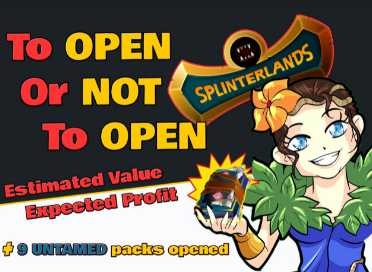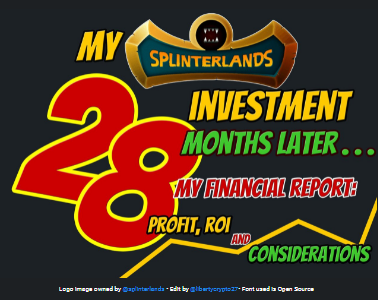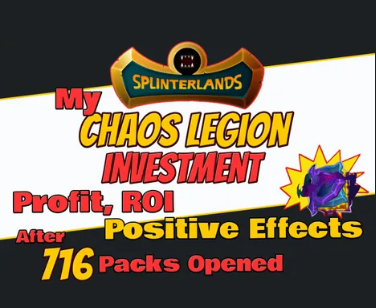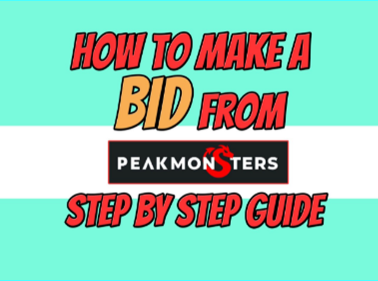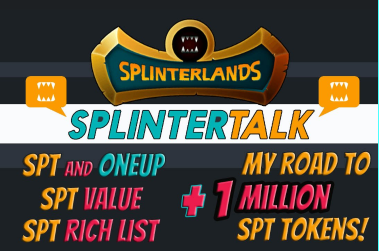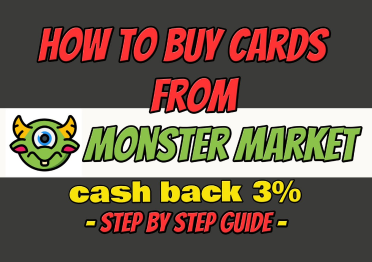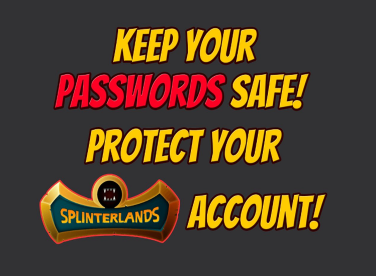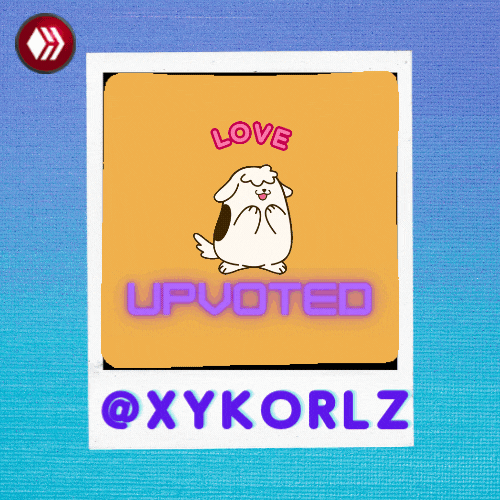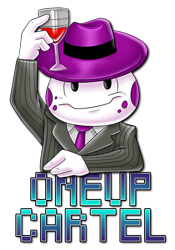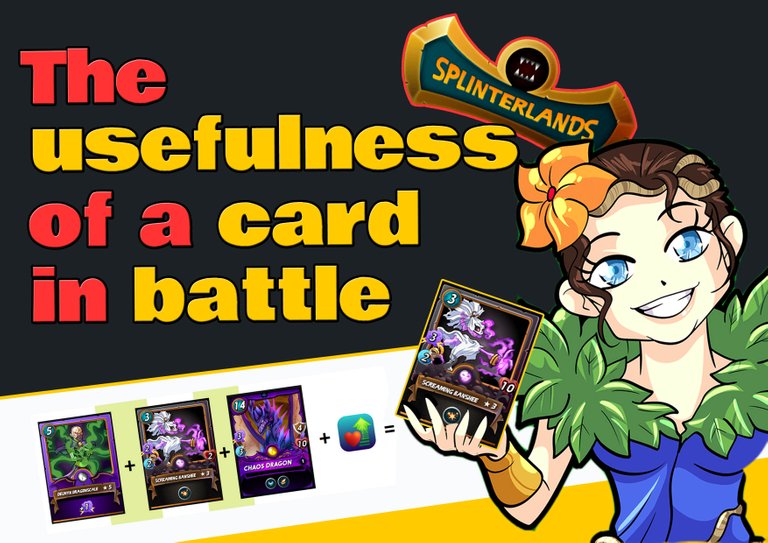
 La versione in italiano è subito dopo la versione in inglese - The Italian version is immediately after the English version
La versione in italiano è subito dopo la versione in inglese - The Italian version is immediately after the English version
I've often received questions from new Splinterlands players like:
What cards are most useful for winning battles?
Which cards do you recommend me to buy?
To the previous questions there is no single answer because the choice of the cards to buy depends on several factors such as the budget that a player wants to invest or the game goal (or league) that a player wants to achieve.
Today I want to write a post that I hope will be useful to the new players of Splinterlands to better understand some dynamics of the game of Splinterlands whose knowledge facilitates the choice of the cards to buy and to use in battle.

The Usefulness of a Card in Battle

Splinterlands is a great game because it's varied:
- each game battle has different combat rules to respect that make each game different from the next.
- There are many cards that can be purchased and used that differ in statistics and abilities and the possible combinations are many and therefore are also many battle strategies to choose from.
For this reason to define the usefulness of a card in battle it is necessary to consider several elements.
In fact a card that can be very useful for me could be less useful for another player.
There are cards that have very strong stats, such as most legendary cards, but in general the battle utility of a card varies because it is influenced by
- the level of the card
- the battle rules
- the summoner or the "friends" cards it is used with in battle.
To show the importance of the elements I've mentioned above, I'll take as an example the Screaming Banshee card, an epic Death element card that I have in my card collection.
Screaming Banshee is a card from the Beta collection that I used a lot in the past and particularly before the release of the Untamed collection.

The importance of a card's level

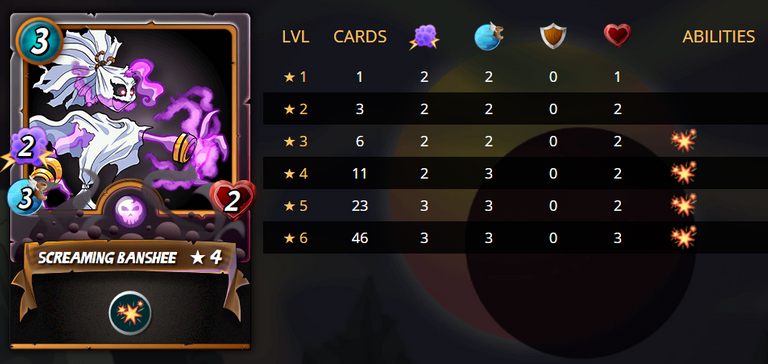
Screaming Banshee (level 1) has two strengths:
- it has a magic attack of 2 points already starting at level 1
- has a very low mana cost: 3 points of mana.
Screaming Banshee (level 1) also has a major weakness, however:
- it has only one life point.
A single life point forces the player using Screaming Banshee in battle to place it in the central positions which are the most protected positions, but most importantly it makes the card usable only in battles that have extremely favorable conditions.
When Screaming Banshee reaches level 3 it becomes more useful and usable in battle because it acquires a very good ability, the Blast ability.
The Blast ability allows a card to hit up to three enemy cards at once:
- the card directly hit
- the cards adjacent to the directly hit card

Screaming Banshee level 6 (max level) becomes much more useful in battle because:
- it has a 3 point magic attack
- has 3 life points that are always few but definitely better than the only life point available at starting level.
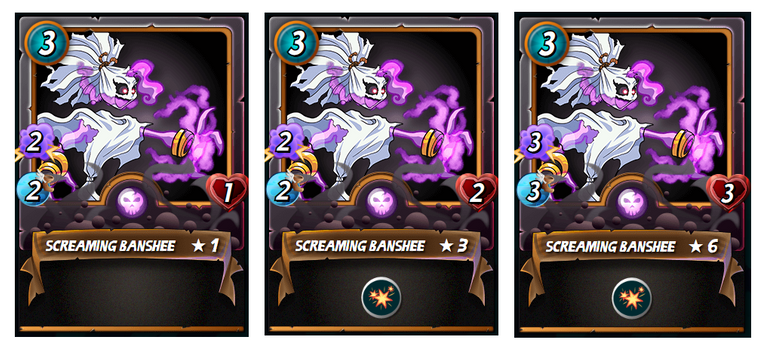

The importance of battle rules

I chose the Screaming Banshee card as an example because it allows me to show in a simple and obvious way the impact that a battle rule can have on the use of a card and the choice of whether or not to use it in battle.

Each card, based on its play stats, can have battle rules that are particularly favorable or particularly unfavorable to its use.
For example, using Screaming Banshee when the battle rule is one of the following is definitely counterproductive:
- Equal Opportunity
Screaming Banshee will be one of the first cards to be attacked and probably eliminated. - Noxious Fumes and Earthquake
Screaming Banshee level 1-5 will most likely be eliminated after the first round of play due to the negative effects of the battle rules.

But when the battle rule is Equalizer the utility of Screaming Banshee increases considerably especially for the card from level 3 onwards.

In fact, Screeming Banshee, thanks to the Equalizer rule, will acquire the life score of the card in battle (both friend and enemy) that has the most life points and will most likely improve its life score and lose its weakness.
In the following image you can see a battle where I used level 4 Screaming Banshee and where its contribution in battle was important.
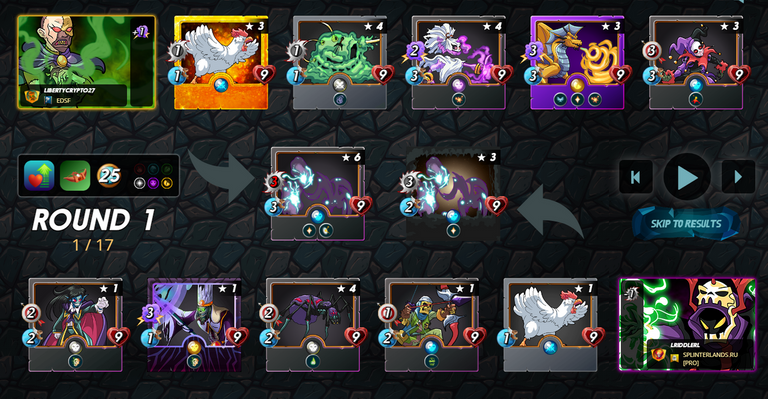

The importance of summoner-type cards

A card's level and combat rules are important in determining a card's usefulness in battle, but there is another element that is just as important:
- The level and ability of the card summoner with which a card is used.
For example, a summoner such as Daria Dragonscale (of any level) will not affect the stats of the level 1 Screaming Banshee card in any way and they will remain the same in battle.
A summoner like Delwin Dragonscale level 1 will positively affect Screaming Banshee's stats because it will increase its magic attack by one point (see image below).
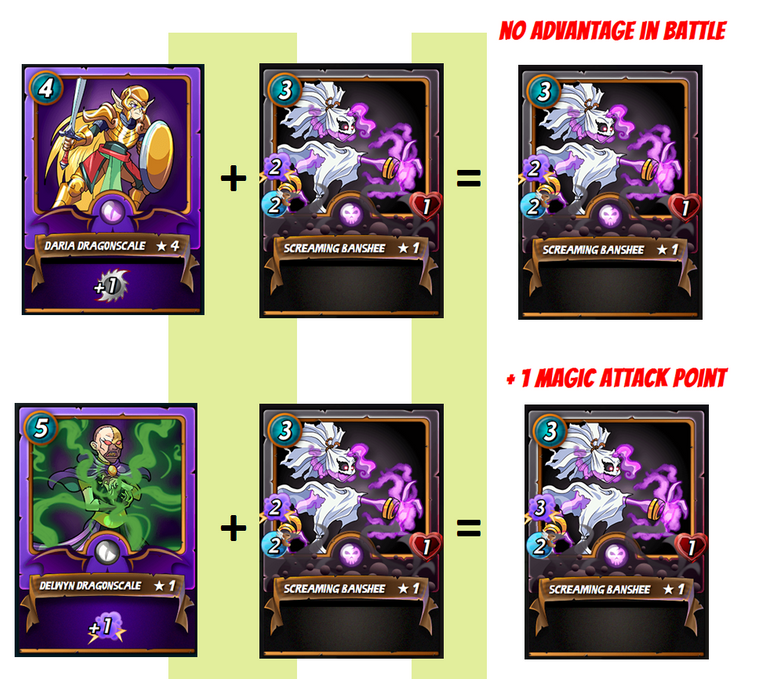
To use monster cards higher than level one, it is necessary to have summoner type cards capable of summoning cards of that level.
I'll take the Delwiyn Dragonscale summoner as an example again.
In the following image you can see the levels reached by Delwyn Dragonscale and in correspondence of each level you can see the level and type of cards that can be summoned (common, rare, epic, legendary)
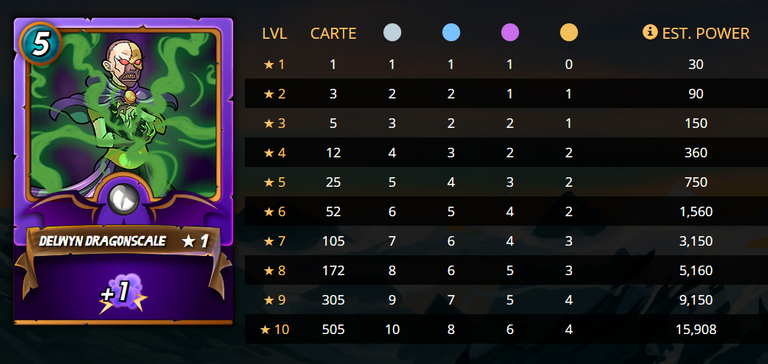
For example, if I field Screaming Banshee of level 3 but I use Delwin Dragonscale of level 1 in battle, I can only use the game stats of the Screaming Banshee level 1 card (see image below).
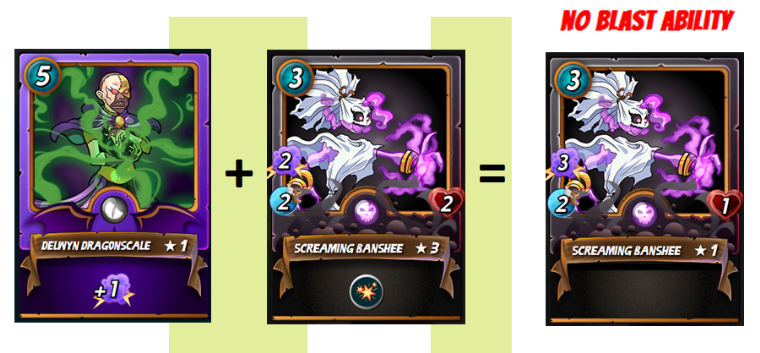
If I field a level 3 Screaming Banshee in battle and use a level 1 Delwyn Dragonscale summoner, I won't be able to use the Blast ability because Delwyn Dragonscale can summon epic cards with a maximum level of 1.

If I want to take advantage of Screaming Banshee's level 3 stats and Blast ability, I need to use a summoner that can summon the card at level 3 such as Delwyn Dragonscale level 5.
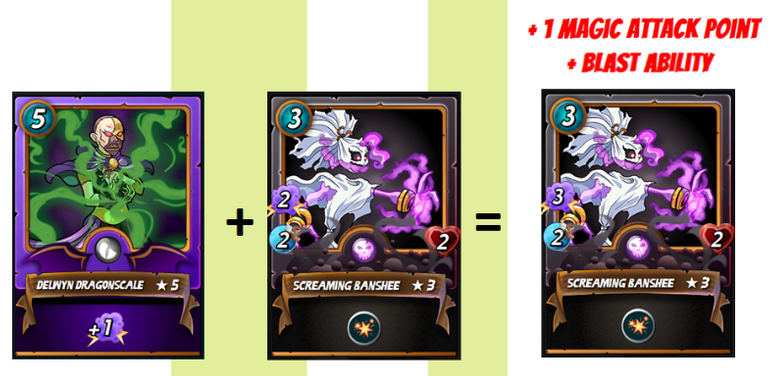

Final Considerations

Splinterlands is a blockchain-based game that offers a lot of earning possibilities because it has a lot of assets (NFT and tokens).
One of the most important assets of Splinterlands are the game cards.
For players like me who enjoy playing and have specific game goals such as getting in a particular league is important to choose carefully the cards to buy to increase the strength of their card collection in battle.
Each card in Splinterlands, in addition to the number of cards in circulation and in addition to its market value, has a battle utility that depends and is influenced by the other cards with which it is used (summoner cards and monster cards) and also by the rules of battle.

The rules of battle that change every game, the many combinations of cards that you can buy and use in battle make the game of Splinterlands a game with multiple levels of strategy and a lot of fun and that is why after 28 months after my first battle I still enjoy it as much as the first day.
In my next post I will show how I choose the cards to sell and the cards to buy to optimize my card collection.
I hope you enjoyed this report of mine and thank you for reading and taking the time to read it :)
Splinterlands = Play 2 Earn!


Are you not a Splinterlands player?

Any game that involves the purchase of cards and tokens is never a simple game but it is also an investment and should be considered as such.
I am not a financial consultant and if you decide to invest in the game of Splinterlands you do it for your own choice, after having made your personal evaluations and considered all possible risk factors.
My advice is to always invest only what you can afford to lose with a light heart.

A selection of my previous Splinterlands posts

HIVE ON and Splinterlands ON!

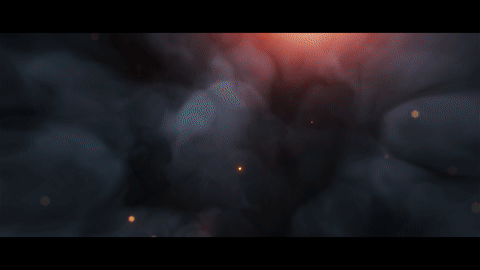





Mi è capitato spesso di ricevere domande dai nuovi giocatori di Splinterlands del tipo:
Quali carte sono più utili per vincere le battaglie?
Quali carte mi consigli di acquistare?
Alle domande precedenti non c'è un'unica risposta perchè la scelta sulle carte da acquistare dipende da diversi fattori come ad esempio il budget che un giocatore vuole investire o l'obiettivo di gioco che un giocatore vuole raggiungere.
Oggi voglio scrivere un post che spero sia utile ai nuovi giocatori di Splinterlands per comprendere meglio alcune dinamiche del gioco di Splinterlands la cui conoscenza facilita la scelta delle carte da comprare e da utilizzare in battaglia.

L'utilità in battaglia di una carta

Splinterlands è un bel gioco perchè è vario:
- ogni battaglia di gioco ha regole di combattimento diverse da rispettare che rendono ogni partita diversa dall'altra.
- ci sono molte carte acquistabili e utilizzabili che si differenziano per statistiche e abilità di gioco diverse e le combinazioni possibili sono molte e quindi sono molte anche le strategie di battaglia tra cui scegliere.
Per questo motivo per definire l'utilità in battaglia di una carta è necessario considerare diversi elementi.
Infatti una carta che può essere molto utile per me potrebbe essere meno utile per un altro giocatore.
Ci sono carte che hanno statistiche di gioco molto forti come ad esempio la maggior parte delle carte leggendarie ma in generale l'utilità in battaglia di una carta varia perchè è influenzata:
- dal livello della carta
- dalle regole di battaglia
- dalla carta evocatore o dalle carte "amiche" con cui viene utilizzata in battaglia.
Per mostrare l'importanza degli elementi che ho elecanto sopra prenderò come esempio la carta Screaming Banshee, carta epica dell'elemento Morte che ho nella mia collezione di carte.
Screaming Banshee è una carta della collezione Beta che utilizzavo molto in passato e in particolare prima del rilascio della collezione Untamed.

L'importanza del livello di una carta


Screaming Banshee (livello 1) ha due punti di forza:
- ha un attacco magico di 2 punti già a partire dal livello 1
- ha un costo in termini di mana molto basso: 3 punti di mana.
Screaming Banshee (livello 1) ha però anche un grande punto di debolezza:
- ha 1 solo punto di vita
Un solo punto di vita obbliga il giocatore che utilizza Screaming Banshee in battaglia a posizionarla nelle posizioni centrali che sono le posizioni più protette ma soprattutto rende la carta utilizzabile solo in battaglie che hanno condizioni estremamente favorevoli.
Quando Screaming Banshee raggiunge il livello 3 diventa più utile e utilizzabile in battaglia perchè acquisisce un'ottima abilità, l' abilità Blast.
L'abilità Blast permette ad una carta di colpire fino a tre carte nemiche contemporaneamente:
- la carta direttamente colpita
- le carte adiacenti alla carta direttamente colpita

Screaming Banshee di livello 6 (max level) diventa molto più utile in battaglia perchè:
- ha un attacco magico di 3 punti
- ha 3 punti vita che sono sempre pochi ma decisamente meglio dell'unico punto di vita disponibile al livello iniziale.


L'importanza delle regole di battaglia

Ho scelto come esempio la carta Screaming Banshee perchè permette di mostrare in modo semplice ed evidente l'impatto che può avere una regola di battaglia sull'utilizzo di una carta e sulla scelta di utilizzarla o meno in battaglia.

Ogni carta in base alle sue statistiche di gioco può avere regole di battaglia particolarmente favorevoli o particolarmente sfavorevoli al suo utilizzo.
Ad esempio utilizzare Screaming Banshee quando la regola di battaglia è una delle seguenti è decisamente controproducente:
- Equal Opportunity
Screaming Banshee sarà una delle prime carte ad essere attaccate e probabilmente eliminata. - Noxious Fumes e Earthquake
Screaming Banshee di livello 1-5 verrà eliminata con molta probabilità dopo il primo round di gioco a causa degli effetti negativi delle regole di battaglia

Ma quando la regola di battaglia è Equalizer l'utilità di Screaming Banshee aumenta in modo considerevole soprattutto per la carta dal terzo livello in poi.

Infatti Screeming Banshee, grazie alla regola Equalizer, acquisirà il punteggio vita della carta in battaglia (sia amica che nemica) che ha il maggior numero di punti vita e con molta probabilità migliorerà il suo punteggio vita e perderà il suo punto debole.
Nell'immagine seguente puoi vedere una battaglia in cui ho utilizzato Screaming Banshee di livello 4 e in cui il suo contributo in battaglia è stato importante.


L'importanza delle carte di tipo evocatore

Il livello di una carta e le regole di combattimento sono importanti per determinare l'utilità in battaglia di una carta ma c'è un'altro elemento altrettanto importante:
- il livello e l'abilità della carta evocatore con cui viene utilizzata una carta.
Ad esempio un evocatore come Daria Dragonscale (di qualunque livello) non influenzerà in alcun modo le statistiche della carta Screaming Banshee di livello 1 che rimarrano uguali in battaglia.
Un evocatore come Delwin Dragonscale di livello 1 invece sarà in grado di influenzare positivamente le statistiche di Screaming Banshee perchè aumenterà di un punto il suo attacco magico (vedi immagine seguente).

Per utilizzare carte mostro di livello superiore al primo è necessario avere carte di tipo evocatore capaci di evocare carte di quel livello.
Prendo di nuovo come esempio l'evocatore Delwiyn Dragonscale.
Nell'immagine seguente puoi vederere i livelli raggiungibili da Delwyn Dragonscale e in corrispondenza di ogni suo livello puoi vedere il livello e la tipologia delle carte evocabili (comune, rara, epica, leggendaria)

Se ad esempio schiero in battaglia Screaming Banshee di livello 3 ma utilizzo Delwin Dragonscale di livello 1 potrò utilizzare solo le statistiche di gioco della carta Screaming Banshee di livello 1 (vedi immagine seguente).

Se schiero in battaglia Screaming Banshee di livello 3 e utilizzo l'evocatore Delwyn Dragonscale di livello 1 non potrò utilizzare l'abilità Blast perchè Delwyn Dragonscale può evocare carte epiche di livello massimo uguale a 1.

Se voglio avvalermi di tutte le statistiche di Screaming Banshee di livello 3 e della sua abilità Blast devo necessariamente utilizzare un evocatore capace di evocare la carta al livello 3 come ad esempio Delwyn Dragonscale di livello 5.


Considerazioni Finali

Splinterlands è un gioco basato su blockchain che offre tante possibilità di guadagno perchè ha tanti assets (NFT e token).
Uno degli assets più importanti di Splinterlands sono le carte di gioco.
Per i giocatori come me che si divertono a giocare e hanno obiettivi di gioco precisi come ad esempio arrivare in una determinata lega è importante scegliere con attenzione le carte da acquistare per aumentare la forza in battaglia della propria collezione di carte.
Ogni carta di Splinterlands oltre al numero delle carte in circolazione e oltre al suo valore di mercato ha un'utilità in battaglia che dipende ed è influenzata dalle altre carte con cui viene utilizzata ( carte evocatore e carte mostro) e anche dalle regole di battaglia.

Le regole di battaglia che cambiano ad ogni partita, le tante combinazioni di carte che è possibile acquistare e utilizzare in battaglia rendono il gioco di Splinterlands un gioco con più livelli di strategia e molto divertente ed è per questo motivo che dopo 28 mesi dalla mia prima battaglia ancora mi diverto come il primo giorno.
Nel mio prossimo post mostrerò come scelgo le carte da vendere e le carte da comprare per ottimizzare la mia collezione di carte.
Spero che questo mio post ti sia piaciuto e ti ringrazio per la lettura e per avermi dedicato il tuo tempo :)
Splinterlands = Play 2 Earn!

Non sei un giocatore di Splinterlands?


Ogni gioco che prevede l'acquisto di carte e di token non è mai un semplice gioco ma è anche un investimento e come tale va considerato.
Io non sono un consulente finanziario e se decidi di investire nel gioco di Splinterlands lo fai per tua scelta, dopo aver fatto le tue personali valutazioni e considerato tutti i possibili fattori di rischio.
Il mio consiglio è di investire sempre e solo quello che puoi permetterti di perdere a cuor leggero.

Una selezione dei miei precedenti post su Splinterlands





